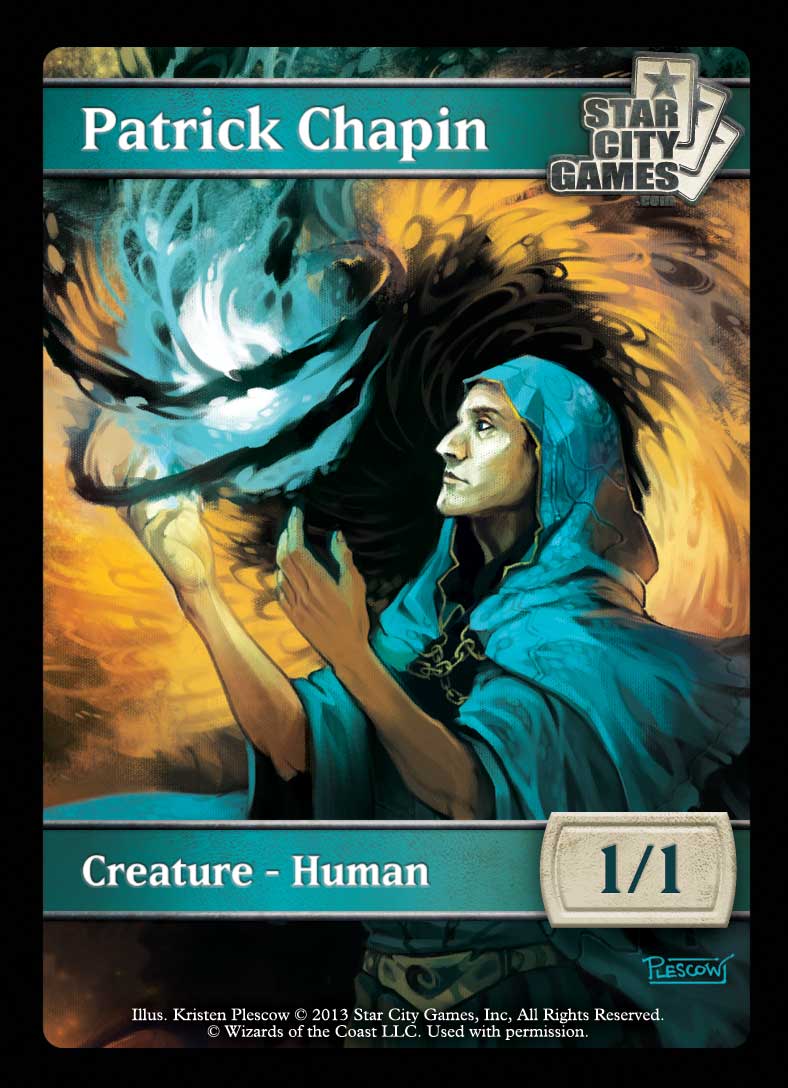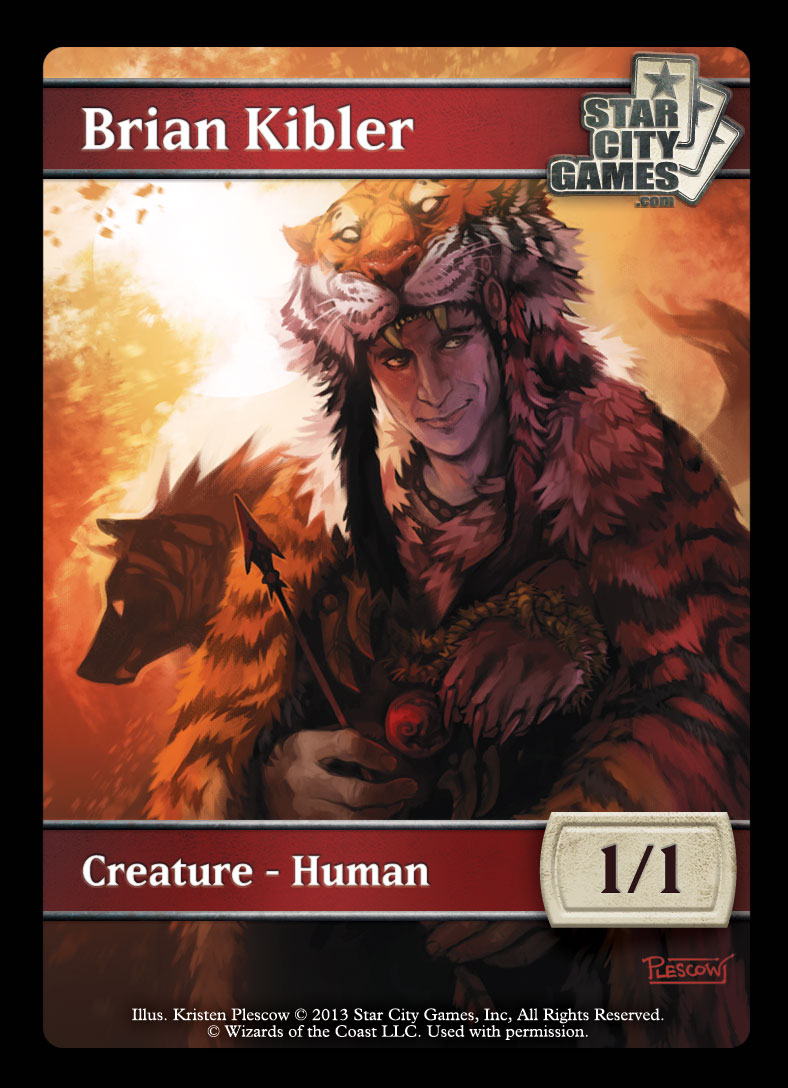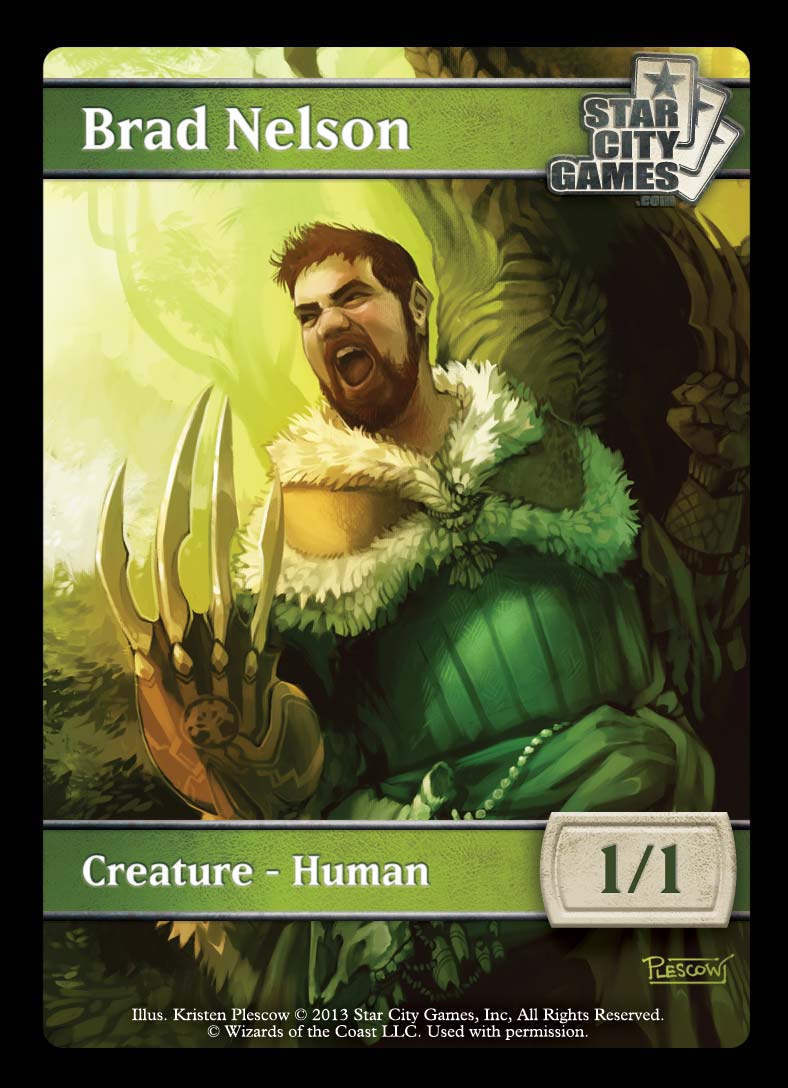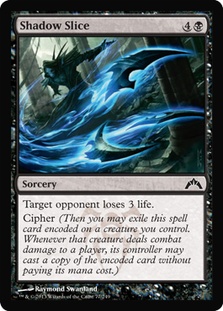Tomorrow StarCityGames.com is blowing out Grand Prix Charlotte!
Here is a crazy video by Evan Erwin talking about all the many reasons you would want to go:
I am going to be on video coverage with SCGLive record-crusher Joey Pasco and great onetime Rookie of the Year Matthias Hunt. Also, I will be appearing with Brad Nelson, Gerry Thompson, Brian Kibler, and Patrick Chapin for the official unveiling of these shiny new things:
Move over Emma Watson, I make black wizarding robes look GOOD.
I have been spending many late nights on Magic Online in order to familiarize myself with the Gatecrash Limited format. Day 2 of the Grand Prix is Booster Draft, but as my editor pointed out, Day 1 is Sealed Deck, which is a rather under-discussed format.
So what we are going to focus on today is Sealed Deck at a high level, some differences between Sealed decks and Draft decks, and some strategies you might want to use to build a Sealed deck whether or not you get an ideal pool.
Core Principles, Mana, and Land Counts
First and foremost, you should probably play 40 cards in your maindeck.
I know this probably is in the "goes without saying" category for most readers, but I am saying it anyway. Sealed Deck—and Limited in general—is generally a format where you have a small number of cards that are substantially more powerful than all the rest of your cards. For example, say you have one Clan Defiance and 39 cards that are weaker than Clan Defiance.
All other things held equal, you want to draw your Can Defiance as often as possible, and the most powerful act you can take as a Sealed Deck player might be to increase your chances of seeing it. If you are playing a G/R deck, your options are limited, but the last thing you want is to play 41 cards, lose a game within x-spell reach, and have that best card sitting on top when you do.
Sealed Deck sometimes gets a bad rap (i.e., "Sealed Luck"), but the reality is that while there might be a lot more out of your control than in Draft, evaluating a pool and building a deck simply utilizes different tools and models. For example, most Draft decks are going to want to be two colors; not necessarily so for Sealed decks. In part because you can’t control your colors—you’re stuck with what you’ve opened—you will have more players who play three colors. But which three?
Play Your Removal
One thing that I noticed playing so far is that there isn’t very much common removal.
The commons pass I took looked something like this:
Angelic Edict 4W
Death’s Approach B
Devour Flesh 1B
Executioner’s Swing WB
Grisly Spectacle 2BB
Mugging R
In fact, the common removal is not only thin, but relatively weak—even for Limited.
Executioner’s Swing requires something to happen ahead of time. Devour Flesh is tough to aim (and makes racing annoying). Smite and Pit Fight are contextually locked enough to feel more like tricks than real removal (though not when you are the victim of one of them rather than the caster). You can extend the contextual list to Bomber Corps and Hands of Binding, which are by nature contingent on attacking.
The uncommon removal is much better. Cards like Killing Glare, Orzhov Charm, and Homing Lightning give us some upgrades. But these aren’t necessarily the cards we can expect to have in Sealed Deck.
Now the rare removal, we are talking about potential blowouts, but again, they are rare (and see the next section). Clan Defiance is an obviously asymmetrical elbow drop and particularly punishing for decks like Orzhov that often play small flyers as well as low toughness ground pounders or extortionists.
Merciless Eviction is like every other Wrath ever. You can sandbag, do a good acting job, get your opponent to overcommit, murder them, and turn it around. Your opponent will be crying to their friends in between rounds. Same as it ever was. So yeah, the rare removal is not only potentially super good, but particularly so in relation to the thinness and relative strength of the common removal.
Altogether, it should be obvious that if most Limited decks plan to win via creatures and common removal is thin, creature removal might be at a premium. One paradigm, therefore, might be to simply put all your playable removal aside and choose colors based on that.
Just Play Your Rares and Stuff
When building a Sealed deck, one first step is to start by sorting playables versus chaff and grouping playables by color.
Not all playables are created equal (Kingpin’s Pet and Aurelia’s Fury would both rate favorably "playable"), and the fact is that most Sealed decks have more than enough playables to add up to 22-23 color-aligned cards. We just said that one way to bias your decisions is around removal. Another way would be to bias in favor of rares and mythic Rares and to play as many as you can.
These are the mythic rares in Gatecrash:
Aurelia, the Warleader
Aurelia’s Fury
Borborygmos Enraged
Deathpact Angel
Domri Rade
Duskmantle Seer
Enter the Infinite
Giant Adephage
Gideon, Champion of Justice
Hellkite Tyrant
Lazav, Dimir Mastermind
Lord of the Void
Master Biomancer
Obzedat, Ghost Council
Prime Speaker Zegana
Enter the Infinite is probably unplayable in Limited, but most of the rest of these cards are somewhere from powerful-if-expensive to unambiguously excellent.
Of the fifteen, eleven are creatures and two are planeswalkers. All other things held equal, creatures (potentially offensive permanents) are better than other kinds of bombs in Limited. I think we can all agree that certain of these creatures are really powerful, and creatures get to be bombs over and over again.
What are the chances the opponent is going to be able to duel Obzedat, Ghost Council on the ground, assuming it gets in play and going? Unlike the Gruul legendary mythic equivalent, Obzedat is both awesome once it gets in play and aggressively costed!
Hellkite Tyrant is basically never going to get its alternate win on in Limited, but it is still a huge 6/5 flying trampler and is pretty reasonably costed for its size and evasion. How long do you think it is going to take to win with that guy attacking? Remember what we said about the removal up top? It can be tough to answer one of these.
Play Your Dual Lands
One of the barriers to winning in Sealed Deck is mana consistency. A deceptively tough day might come from a three-color deck with a reasonable curve and solid high end—that has a 6/6/6 mana base. That kind of mana base just dramatically limits your consistency early, meaning even though your curve is good, you don’t necessarily get to play your cards when you want to even if you are making your drops!
So one last tiebreaker is to build around the dual lands you get. Did you win the Stomping Ground lottery? What Guildgates came in your packs? Especially if it doesn’t mean leaving bomb mythics or great removal in your sideboard, building around lands that can best enable your consistent development is one other factor that can be helpful in gaining value for many different pools.
Okay, those are three models for picking colors at the onset.
But they are kind of rich people paradigms, you know?
Not everyone has removal to lean on in their Sealed deck, or bomb Mythic Rares to dictate what colors to play, or even any dual lands. What do you do if you can’t lean on one of these strategies?
Play More or Fewer Lands Total
Generally speaking, if you’ve got good cards—and especially if you are playing three colors—I would recommend playing eighteen lands. This is probably especially relevant if you are Orzhov because having extra mana to pay for extort over time will allow you to get that much more out of your cards.
However, you don’t always have to play eighteen. Here are two times you might want to go in another direction:
1. You Are a Beatdown Deck
Beatdown decks tend to be less common and less effective in Sealed Deck than in Draft. In Draft, you get to draw a line in the sand early, pick all the cheap Gruul or Boros cards, and start jamming attack phases with battalion and bloodrush.
The same kinds of cards are available in Sealed Deck, but because you don’t dictate which ones you have (you are stuck with what you open instead of proactively crafting a deck), your finished product can be less refined. For instance, this might be a much less effective strategy if you are forced to play three colors. Beatdown decks in Limited—as in Constructed—thrive on being able to get drops down and seize the initiative before the opponent has gotten their game established. That is going to be hard to do if you have a premium W one-drop in your opener but are staring at a Mountain and a Forest.
In addition, Sealed decks tend to be higher power level than Draft decks for the reasons we already touched on. People play their bombs and build their decks around their removal. That is not to say that they are "better" than Draft decks, but they do tend to have higher top ends on average. Therefore, if the opposing Sealed deck gets its game established (in no small part because your beatdown deck didn’t mercilessly kill him on the fourth turn, you are going to have to deal with high-end stuff and might not have the tools to do so.
Playing the beatdown in Sealed Deck can be challenging. If you go this route—and that is usually because you couldn’t go a more powerful one—you are going to be most successful if you can keep it to two colors and keep your curve low but your early pressure high.
2. You Consistently Choose to Draw
This is an old trick from Dave Price.
You only play seventeen lands, but you go second given the choice. Your average opponent is going to choose to play most of the time, so that is cooperative. If you win the roll, you choose to go second.
This is the bet:
In Constructed, there is generally a huge advantage to going first. Counterspells get online before you are dead, beatdown creatures hit before the opponent can stabilize, ditto on combo, et cetera, ad infinitum.
In Limited, there can be some benefit to going first for largely the same reasons (and especially if you are the beatdown deck) or more in Draft. Many players, therefore, don’t even consider going second.
There is an undeniable benefit to getting an extra card! It’s just in Constructed or when beating down in Draft, the benefit of going first is usually greater. That said, the benefit of an extra card is magnified if you are playing a mana-light deck. You can see one more card and therefore keep more hands. We already said that most Sealed decks take a while to get going, play three colors, and end up somewhere in Bombsville. If you aren’t getting jumped all over, the trade-off of going second is minimized in the short term.
An alternative is to play eighteen lands (properly) to start and to side down to seventeen lands if you know you can control going second (you lost game 1 and get to choose or you won game 1 and your opponent already chose to play once).
Playing only seventeen lands—or sixteen in extreme cases—is one underappreciated way for a less powerful deck to beat a bomb-laden more powerful one. You are less likely to get mana flooded, and you can jam one more spell to push over a game, especially when the opponent stalls, floods, or stumbles. Remember: you were unlikely to win a fair fight anyway.
Play Your Card Advantage!
I might not be one to talk as I have been playing approximately 66-75% too many Purge the Profanes in Draft, but I think that in Sealed Deck an undervalued two-for-one might just be disproportionately effective and even pretty strategic.
I mean, do the math.
Slower to develop.
Three colors, where most people are on eighteen lands and planning to hit their land drops.
What do you think is still in hand after turn 4? What do you think is going to happen when you hit a Purge the Profane two-for-one (and God forbid a second one the next turn)?
That’s right: you are going to take money, their bombs, maybe even cripple them.
With a low priority Purge the Profane!
You can actually play a card like that the same way you can milk the battlefield with Merciless Eviction: plan for it and play to it and it just might prove more effective than it is "supposed" to.
You Find Ways to Win and Build Your Deck to Exploit Them Over Time
Even bad Sealed decks have got something.
You might not have tons of removal and bomb mythic rare creatures. You might not be able to run a lean and efficient beatdown deck. But as with any deck, you can put together a repeatable strategy, try to play for it, and get good at it over the course of a day.
One example of a legitimate end game you can play for is with a common card like Shadow Slice.
If you have an evasion creature on the battlefield, you can turn Shadow Slice into a pretty quick six to nine bonus damage, especially if you did something like nailing the opponent with Purge the Profane the turn before.
You Shadow Slice the opponent for three, encode it on your evader, attack (deal whatever that guy was going to deal), and then add three more onto it. If you are Orzhov, this is already giving you multiple opportunities to extort for even more damage!
Now you can untap and hopefully get in for another three+.
The amount of setup for this end game isn’t actually that difficult, especially if you know what you are going for. And—again provided you have a relevant evader—it can be a tough end game for even powerful decks to set up against.
Generally, for Gatecrash…
Especially if you are unused to Sealed Deck or Limited relative to Constructed, certain partnerships might seem initially counterintuitive. For instance, someone using a Burning-Tree Emissary to make a Bomber Corps on the second turn. Wait a minute! That’s Gruul! And that over there is Boros! This is like dogs and cats loving each other!
Or Orzhov decks using the repeated encoding on various Dimir cipher cards to set up extort. Color rather than guild crossover.
As a general note of caution, I have found that there is rarely if ever a great block when the opponent has open green mana. Bloodrush has decided more Limited games for me (and against me) than anything else. By the by, we again see how Purge the Profane can be effective—it cuts off a commonly played and highly effective basic strategy!
That said, a lot of the games are simply decided by speed of deployment to the battlefield. It’s tough to play even with a Boros deck that has battalion online early, but you can be surprised the games Orzhov seems behind in both size on the field and life total but pulls it out with perfect extorts to stay alive, evasion, and maybe one good swing. This of course being at least in part a product of the much-discussed common removal situation.
More, much more, of these interactions at GP Charlotte!
Tune in to SCGLive for all the action!
LOVE
MIKE






